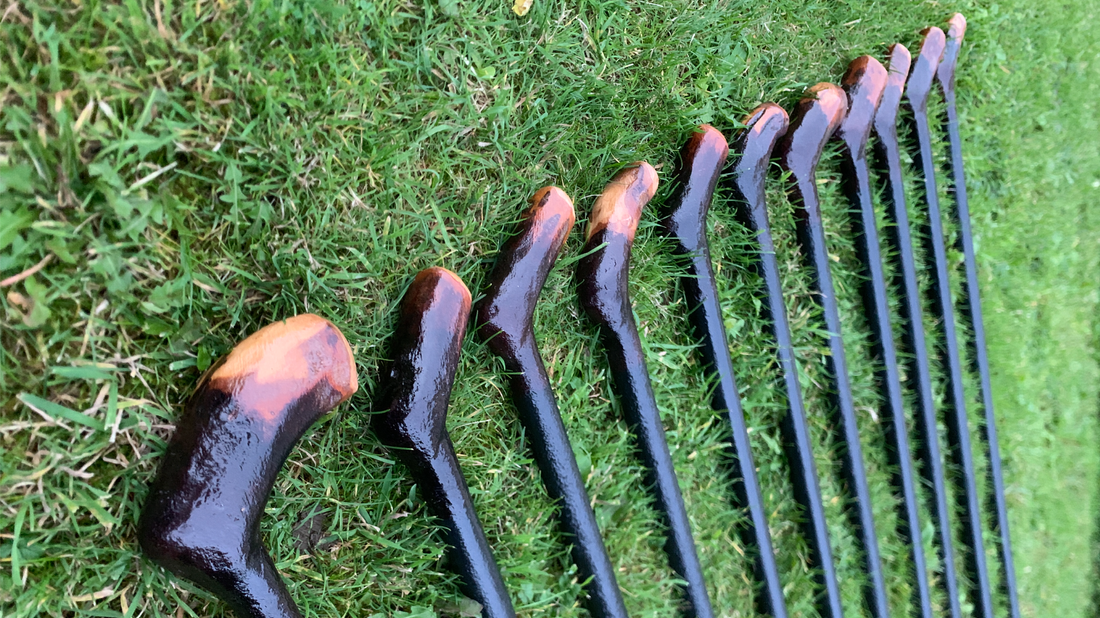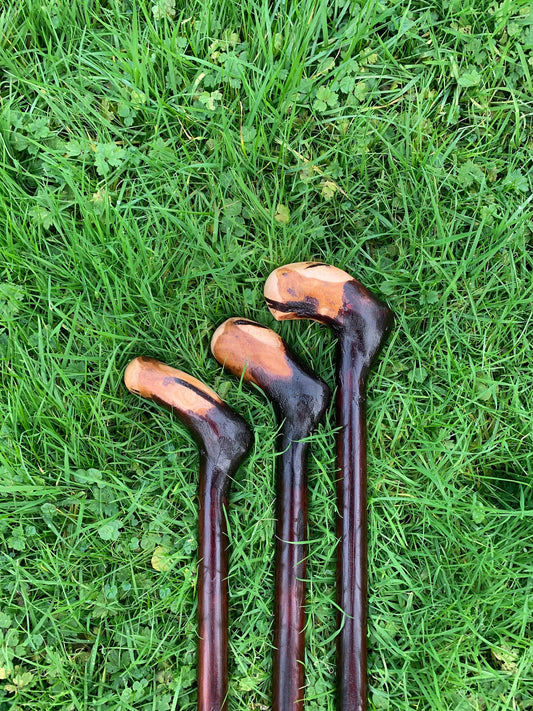
History of the Irish Shillelagh / Blackthorn Walking Sticks
Share
For centuries, walking sticks have been a symbol of strength, authority, and elegance, but one variety stands out for its rich Irish cultural history, craftsmanship, and symbolic significance—the Irish blackthorn walking stick. These sticks hold deep-rooted connections to heritage, folklore, and personal defence here in Ireland.
What is Blackthorn?
Prunus spinosa, commonly known as blackthorn or sloe, is a small flowering shrub native to Ireland and commonly found growing in hedgerows surrounding farms. It produces a dark purplish/blue fruit called sloe (see photo below), used to make sloe gin, but it’s the wood that is most useful due to it being a dense hardwood in combination with its knotted and thorny appearance, giving this wood a unique and rugged appearance, perfect for any shillelagh.

Early on, Shillelagh
The Shillelagh, or in Irish, Síol Éalaigh, origins can be traced back to the rural landscapes of Ireland, where it was used as a means of defence and to rebel against the occupying British. In the 18th and 19th centuries, blackthorn was crafted into cudgels, known as a shillelagh, which served as weapons for self-defence.
Blackthorn is a tough hardwood, making it ideal for these purposes. After being cut, the wood was often cured and seasoned for a minimum of two years to enhance its strength and durability. Traditional methods included burying the wood in manure or smothering it in butter and placing up a chimney, allowing the smoke to toughen it. The result was a solid, weighty stick that could deliver a powerful blow, if necessary.
The Shillelagh and Irish Martial Tradition
The shillelagh, a short, club-like weapon thought to be named after the Shillelagh Forest in County Wicklow, Ireland. These weapons were used in bataireacht, an ancient Irish martial art focused on stick-fighting. In the 19th century, Bataireacht was popular due to widespread faction fighting, where local disputes were often settled with clubs instead of fists or swords.
Blackthorn sticks, with their short, stout build, are perfect for close combat. Its association with both martial skill and Irish identity made it a symbol of pride and defiance, particularly during times of colonial rule. It was common for locals to carry a blackthorn stick, or shillelagh, as it was not only practical but also a statement of resilience and independence.
19th and 20th Century: From Self-Defence to Fashion
Moving forward, walking sticks had become a symbol of status and refinement, particularly among the upper classes in Ireland. The blackthorn’s distinctive, rugged look made it popular among gentlemen who wanted a walking stick that was not only elegant but also reflected a sense of masculinity and heritage.
While many blackthorn sticks maintained their defensive potential, the focus shifted toward craftsmanship and design. The stick's handle, carved from the blackthorn root, was carefully shaped and smoothed by hand. It made for a comfortable, good-looking grip. People valued these sticks for their quality, strength, and ties to Irish culture.
By the early 20th century, blackthorn walking sticks had become a sought-after souvenir for visitors to Ireland, in particular Americans, often presented as gifts or keepsakes. They were no longer primarily tools for protection but rather a nod to the past, symbolising Irish heritage and tradition.
Today: A Symbol of Heritage
Blackthorn walking sticks continue to hold a place in Irish culture. While they are less likely to be used as weapons, their cultural significance remains. In recent years, the blackthorn walking stick has seen a resurgence in popularity, partly due to the growing interest in traditional craftsmanship and cultural artefacts. Stick makers continue to cut blackthorn and make walking sticks and shillelaghs using traditional methods passed down through generations. For those interested in owning their own blackthorn walking stick, check out our Blackthorn Walking Stick Collection, where tradition meets craftsmanship.
For many, owning a blackthorn walking stick is a way to connect with Irish history and ancestry.
Conclusion
The history of the blackthorn walking stick is a testament to the enduring power of cultural traditions. From its origins as a practical tool and weapon in rural Ireland to its modern-day use as a walking stick or a symbol of heritage, the blackthorn walking stick embodies both physical strength and cultural pride. Whether used for walking, displayed as a piece of art, or cherished as a family heirloom, the blackthorn stick continues to captivate people with its rugged beauty and rich history.
Now is the perfect time to own a piece of this storied tradition. Explore our exclusive Blackthorn Walking Stick Collection and find the perfect stick that combines history, craftsmanship, and heritage.


